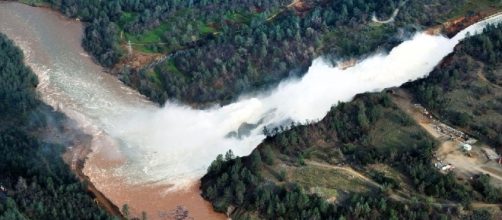River of Concern
The Oroville Dam is the highest in the nation and the lake is the playground of the West Coast and surrounding areas. Known for its sheer size, Lake Oroville with 3.5 million acres of water is now anything but playful. Last Sunday, officials evacuated 200,000 people, sending them in droves across freeways, one and two lane roads, and even through the mud to find places of refuge.
The huge outflows of people, some of whom camped on the side of the road in the rain and others who made it to centers, were terror stricken.
The fear was that the emergency spillway, created nearly 54 years ago would fail, sending a 30 foot wall of water toward towns along the Feather River.
Atmospheric River
Another atmospheric river is hitting the area today and will last at least through next Tuesday. Officials had hoped to bring the lake level down 50 feet but fell short only reaching a 36 foot reduction by Thursday. Releases are still ongoing but the main spillway release has been lowered from 100,000 cubic feet per second to 80,000 cubic feet per second still below the normal rate.
During the past week helicopters have dropped rocks into the eroded spillways. Although residents have been allowed to return home many have elected to stay in the foothills with family and friends.
People fear that with both spillways damaged and using rocks as band-aids, the spillways will not hold through the next influx of storms. Officials claim that with repairs underway, people can feel more secure but must prepare to evacuate at a moment's notice.
The Central Valley, residing at the base of the Sierra Nevada's is a vast flood plain. The network of rivers, lakes, and levees has helped turn the inland sea into a fertile plain that feeds the nation. This sea has only one outlet, the Carquinez Strait which eventually empties into the San Francisco Bay. The strait is narrow making the runoff even slower in releasing pressure on Central Valley waterways.
Feather River
Towns along the Feather River have suffered through the economic downturn.
Two-lane roads are now one-lane roads. Potholes make driving from places like Browns Valley to Oroville treacherous and are prone to flooding naturally. During the evacuation last Sunday, people escaping the valley floor to Nevada County were turned back at the bridge over the Feather River located on 5th Street between Marysville and Yuba City. Gas stations ran out of gas and the homeless were left stranded.
Some residents with cars had to return home as there was no way out of the valley. They were told to expect a 30 foot wall of water starting at the spillway then flattening out as it bled downstream. One person told me that she and her husband planned to get to the roof of their house once the wall of water arrived.
Officials claim that those who wanted to evacuate could. Their assertation has been refuted by first-hand accounts of road closures and congested freeways. Many just went home and prayed.
oroville dam's flood control manual hasn't been updated for over 50 years. In 2005 authorities were warned about certain flaws in construction such as erosion and catastrophic failure. State and Federal management ignored the warnings and the matter faded away. The past 7 years of drought would have been the perfect time to made much needed repairs to the Central Valley waterways and dams.
Evidence supporting state and federal neglect of dams and levees in the Central Valley appear indisputable.

